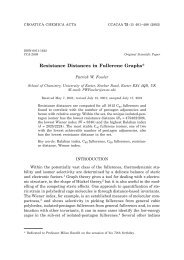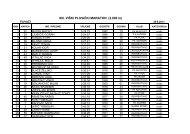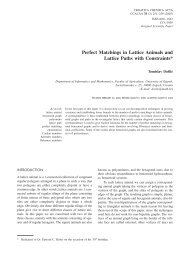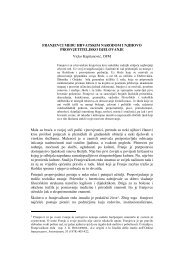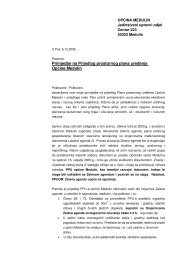450 I. LUKOVITSW is one of the most freqnently applied graph theoretical invariants. Whas been used to explain the variation in boiling points, molar volumes, refractiveindices, heats of isomerization and heats of vaporization of alkanes. 1Later heats of <strong>for</strong>mation, atomization, isomerization, and vaporization aswell as density, critical pressure, surface tension, viscosity, melting points,partition coefficients, chromotographic retention indices, and stability ofcrystal lattices of various kinds of molecules were related 2,3 to W. Besideschemistry, the concept of the <strong>Wiener</strong> number has been used in electricalengineering 4 and mathematics. 5 Quite a few graph invariants related to Whave been proposed, too. 6In addition to Eq. (1), analytical <strong>for</strong>mulas have been proposed <strong>for</strong> W.<strong>Wiener</strong> derived a <strong>for</strong>mula <strong>for</strong> chains 1 (i.e. <strong>for</strong> acyclic structures having twoendpoints), Entringer et al. 7 and Bonchev et al. 8 proposed <strong>for</strong>mulas <strong>for</strong> simplecycles, Trinajsti} et al. obtained <strong>for</strong>mulas <strong>for</strong> polymers 9 and Gutman derived<strong>for</strong>mulas <strong>for</strong> various types of acyclic graphs. 10 A <strong>for</strong>mula was also derived<strong>for</strong> fused bicyclic structures. 11 Canfield et al. proposed a recursionmethod to obtain appropriate <strong>for</strong>mulas <strong>for</strong> any acyclic structure. 12 Each ofthese <strong>for</strong>mulas is valid <strong>for</strong> a given set of <strong>homeomorphic</strong> structures, polymersor stars. Two graphs are <strong>homeomorphic</strong> if both can be obtained from thesame graph by a sequence of subdivisions of lines. For example any two cyclesare <strong>homeomorphic</strong>, any two chains are <strong>homeomorphic</strong> and the star depictedin Figure 1 is <strong>homeomorphic</strong> with the structure depicted in Figure 2.In this paper, a method will be proposed that allows to obtain <strong>for</strong>mulas <strong>for</strong> abroader set of structures.Figure 2. Example of a »starlike« graph containing three chains. k =2,m =3,andn= 4. The branching vertex belongs to all three chains.DERIVATION OF FORMULASExpressions »vertex« and »atom«, »chemical structure« and »graph«,»bond« and »edge«, »valence« and »degree« are synonymous words used inchemistry and graph theory, respectively, and will be used interchangeablyhereafter.Consider a »starlike« graph (Figure 2) that has a single branching vertex,and three side-chains k, m, and n, where k, m and n denote both thenumber of vertices of the side chain and the side-chains themselves. A starlikegraph (Figure 2) is <strong>homeomorphic</strong> with a star which has a branching
FORMULAS FOR NON-HOMEOMORPHIC GRAPHS 451vertex of the same degree (Figure 1). The branching atom belongs to allside-chains. Example: isobutane (Figure 1) consists of three side chains, andeach side chain contains two vertices. Instead of »side-chain«, we shall usethe expression »string« to denote a chainlike subgraph starting with an endpointor a branching vertex and ending with and endpoint or a branchingvertex. An atom between these two vertices (if any) is bivalent.The <strong>Wiener</strong> index of a starlike graph containing strings k, m and n (Figure2) may be calculated by using the following <strong>for</strong>mula: 2,3W = (k 3 + m 3 + n 3 )+3(k 2 m + k 2 n + m 2 n + km 2 + kn 2 + mn 2 )––6(k 2 + m 2 + n 2 )–6(km + kn + mn) +5(k + m + n)/6. (2)For isobutane with k = m = n=2, we obtain:W = (2 3 +2 3 +2 3 ) + 3(2 2 2+2 2 2+2 2 2+22 2 +22 2 +22 2 ) – 6(2 2 +2 2 +2 2 ) – 6(22 +22 +22) + 5(2 + 2 + 2)/6 = (24 + 144 – 72 – 72 + 30)/6 = 9, thesame value that was obtained by using Eq. (1). Eq. (2) remains valid if anyof the side chains disappears, i. e. the size of the corresponding string – e.g.n – is equal to 1. Let us use Eq. (2) to obtain W <strong>for</strong> propane, then k =3,m = n = 1, and W = (3 3 +1 3 +1 3 ) + 3(3 2 1+3 2 1+1 2 1+31 2 +31 2 +11 2 ) – 6(3 2 + 1 2 + 1 2 ) – 6(31 +31 +11)+5(3+1+1)/6 = (29 + 78 – 66 – 42 + 25)/6 = 4, in accordance with thevalue that could be obtained <strong>for</strong> the (hydrogen suppressed) graph of propane.We want to derive a similar <strong>for</strong>mula <strong>for</strong> a starlike graph containing fourstrings k, m, n and o (Figure 3) and the <strong>for</strong>mula should have the following<strong>for</strong>m:W = A 4 (k 3 + m 3 + n 3 + o 3 )+B 4 (k 2 m + k 2 n + k 2 o + m 2 n + m 2 o + n 2 o ++km 2 + kn 2 + ko 2 + mn 2 + mo 2 + no 2 )+D 4 (k 2 + m 2 +n 2 + o 2 )++ E 4 (km + kn + ko + mn + mo+ no) +F 4 (k + m + n + o)/6 (3)Figure 3. Example of a »starlike« graph containing four chains. The branching vertexbelongs to all four chains, k =2,m =3,n =4,ando =5.



